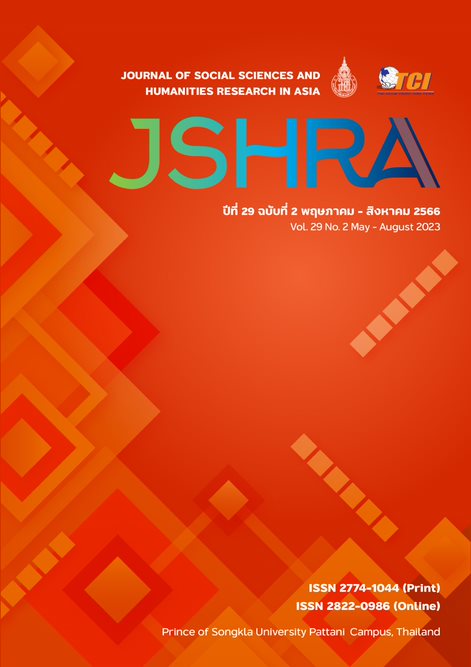Foreign Direct Investment and Income Inequality in ASEAN - 5
Keywords:
Balanced Panel Data Analysis, Foreign Direct Investment, Gini Index, GovernanceAbstract
The analysis of the impacts of the governance in focusing Foreign Direct Invesment(FDI) attention associated with income inequality on the spatial and temporal dynamics in ASEAN-5 was conducted under Fixed Effect Model (FEM) and Random Effect Model (REM) using the balanced panel data analysis over the period of 2002-2018. One of the main findings indicated that ASEAN-5 countries with different economic conditions not only tended to have different effects of FDI on income distribution nevertheless, also contributed to increasing in income inequality. In addition, GDP per capita, Trade openness, Gross Capital Formation, and Governance which are important indicators for economic growth and development would not reduce inequality, rather they led to an income disparity especially in the middle-income countries. The findings revealed that the dispersion of income can be mitigated by increasing FDI productivities which might help to optimize these countries’ potential in the good governance. We concluded that ASEAN-5 countries could achieve better economic growth and development with higher quality of governance. The adoption of national and regional policies should be balanced with FDI-related measures and good governance to create better sustainable economic development and to ensure more equitable distribution of income.
References
Angeles - Castro, G. (2011). Direct investment on inequality: Do governance and macroeconomic stability matter? Economía Mexicana, Nueva Época, XX(1), 181 - 219.
ASEAN Secretariat. (2021). ASEAN statistical yearbook. Jakarta, Retrieved December 14, 2021, from https://www.aseanstats.org/publication/asyb-2021
Baltagi, B.H. (2015). Econometric analysis of panel data (5th ed.). New York: John Wiley & Son.
Bilgin, M.H., Haug, A.A., & Ucal, M. (2016). Income inequality and FDI: Evidence with Turkish data. Applied Economics, 48(11), 1030 - 1045.
Bende - Nabende, A. (1999). FDI, regionalism, government policy and endogenous growth: A comparative study of the ASEAN - 5 economics with the development policy implication for the least develop countries. Aldershot: Ashgate.
Choi, C. (2006). Does foreign direct investment affect domestic income inequality. Applied Economics Letters, 13(12), 811 - 814.
Cowell, F.A. (2011). Measuring inequality. Oxford: Oxford University Press. (Published to Oxford Scholarship Online: April 2015). Figini, P., & Görg, H. (2007). Does foreign direct investment affect wage inequality? An empirical investigation. The World Economy, 34(9), 1455 - 1475.
Franco, C., & Gerussi, E. (2012). Trade, foreign direct investments (FDI) and income inequality: Empirical evidence from transition countries. Journal of International Trade and Economic Development, 22(8), 1131 - 1160.
Kohpaiboon, A. (2006). Multi enterprises and industrial transformation: Evidence from Thailand. Cheltenham: Edward Elgar.
Mah, J.S. (2015). The effect of foreign direct investment inflows on income inequality: Evidence from China. Global Economy Journal, 15(4), 443 - 453.
Mai, P.H. (2004). Foreign direct investment and development in Vietnam: Policy implications. Singapore: ISEAS Publishing
Matallah, S. (2019). The triptych migration - inward FDI - inequality in South Asian countries: How much do governance and institutions matter? Migration and Development, 8(1), 93 - 118.
Meon, P., & Harms, P. (2018). Good and useless FDI: The growth effects of greenfield investment and mergers and acquisitions. Review of International Economics, 26, 37 - 59.
Nunnenkamp, P., Hühne, P., & Herzer, D. (2014). FDI and income inequality, Evidence from Latin American economies. Review of Development Economics, 18(4), 778 - 793.
Nguyen, T.D., Pham, H.C., Do, Q.A., & Le, Q.H. (2021). The impact of foreign direct investment on income inequality in Vietnam. Economies, 9(1), 27.
OECD. (1999). Foreign direct investment and recovery in Southeast Asia, OECD proceeding. Centre for Cooperation with Non - Members. Retrieved December 14, 2021, from https://www.oecd.org/investment/investmentfordevelopment/40818364.pdf
Ostry, J.D., Berg, A., & Tsangarides, C. (2014). Redistribution, Inequality, and Growth. In IMF Staff Discussion Note, 14/02. Retrieved December 14, 2021, from https://www.imf.org/external/pubs/ft/sdn/2014/sdn1402.pdf
Pesaran, M.H., & Smith, R. (1995). Estimating long - run relationships from dynamic heterogeneous panels. Journal of Econometrics, 68(1), 79 - 113.
Teixeira, A.A., & Loureiro, A.H. (2019). FDI, income inequality and poverty: A time series analysis of Portugal, 1973 - 2016. Portuguese Economic Journal, 18(3), 203 - 249.
Tongzon, J. (1998). The economies of Southeast Asia: The growth and development of ASEAN economies. MA: Edward Elgar.
UNCTAD & ASEAN Secretariat. (2018). ASEAN investment report 2018: Foreign direct investment and the digital economy in ASEAN. Jakarta: ASEAN Secretariat.
UNCTAD. (2019). World investment report: Special economic zones. New York: United Nations.
UNCTAD. (2020). World investment report: International production beyond the pandemic. New York: United Nations.
UNCTAD. (2021). World investment report: Investing in sustainable recovery. New York: United Nations.
Van, O.F., Boschma, R., Xiao, J., & Cortinovis., N. (2017). Quality of government and social capital as drivers of regional diversification in Europe. Journal of Economic Geography, 17(6), 1179 - 1208.
World Bank. (2020). Global economic prospects. Washington DC: The World Bank.
World Bank. (2021) World development indicators, Atlas method. Retrieved December 14, 2021, from http://data.worldbank.org/indicator











